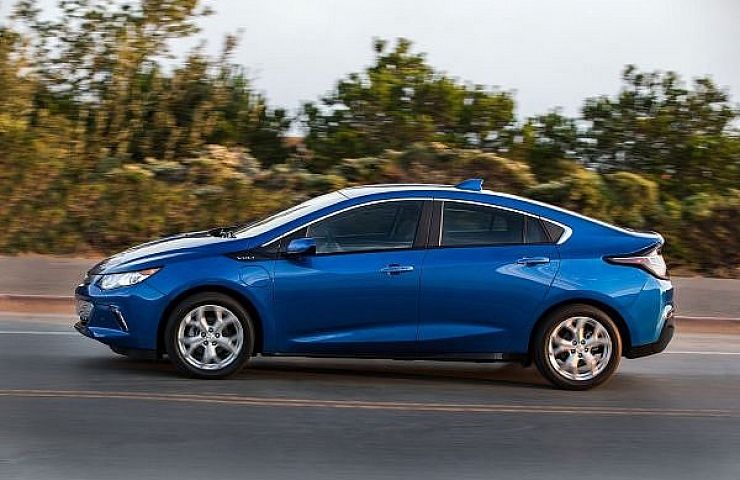If electric cars are going to emerge from their current position as quirky high-tech gizmos, they will need to become more mainstream in their appearance, driving range, and the value brought to drivers. That’s exactly what we are starting to see, especially in the second-generation version of the Chevrolet Volt (shown above). The Volt plug-in hybrid, along with the all-electric Nissan Leaf have been the top selling plug-in cars for the past six years. Based on our recent time behind the wheel of both cars, the Leaf and Volt continue to serve as the gold standard for EVs under $40,000.
More Range
The second-generation Chevy Volt plug-in hybrid was completely redesigned. The biggest upgrade was the use of a larger, lighter, and more powerful battery pack that grants 53 miles of all-electric driving before the gas engine is brought to life. We discovered that it was easy to cruise for 60 miles on the highway before exhausting all the electrons.
The internal combustion engine, which will barely get used if your commute is less than 50 miles, is an all-new aluminum 1.5-liter four-cylinder unit making 101 horsepower. The battery and gas power plants combine to provide more than 350 miles of total range.
We enjoyed the Volt’s driving manners. The car feels exceptionally quiet—with next to no noise or vibration even after the gas engine fires up. A new “regen on demand” button on the steering wheel allows drivers to max out on regenerative braking. When selected, the car is brought to nearly a full stop without touching the brake, a strategy for pushing the limits of its all-electric range.
The Volt’s exterior is widely viewed as more attractive and mainstream than the predecessor. That’s a good thing. The Volt chassis is based on the GM front-wheel-drive Delta II family—shared with the Chevy Cruz and Buick Verano.
The interior is also new, borrowing the interior design language of cars like the Chevy Malibu and Impala. Two eight-inch touchscreens supply dashboard information. The Volt offers the latest high-tech gear, including LTE Wi-Fi hotspots, On-Star, and Apple Car Play, as well as intelligent safety systems like auto parking, collision avoidance, and lane departure warning.
The 2016 Volt is billed as a five-passenger car, and the front seats are large and comfortable, but the rear seat is very tight for three adults. Our only other gripe is the continued use of an onboard charger rated at 3.6 kilowatts—resulting in charging that is slower than competing electric models.
Pricing for the 2016 Chevy Volt before incentives ranges from about $33,000 for the base trim up to $38,000 for the range-topping Premier version.
2016 Leaf: Up to 107 Miles, Before The Next Big Leap
The all-electric Nissan Leaf was first introduced as a 2011 model. It’s the best selling battery-electric car in history with more than 200,000 units sold worldwide.
Nissan announced that in 2017 the second-generation Leaf will be released with an estimated range of about 200 miles. So 2016 is the last example of the original model.
The Leaf continues to sport is quirky design in 2016—with only minor changes in colors. The most important revision for 2016 is a larger 30 kilowatt-hour battery in its SV and SL trim levels. This ups the driving range to 107 miles on a full charge, according to federal ratings.
In our time with the 2016 Leaf, we were easily able to break the 100-mile mark in normal city and highway driving—and managed nearly 120 miles on a single charge in stop-and-go city driving. When using a public Quick Charge station, we were able to recharge a drained battery pack up to 78 percent of its range in 30 minutes. The 240-volt supply used in most homes requires about five hours for a complete recharge.
Pricing for the 2016 Leaf, before incentives, is about the same as in previous years—ranging from below $30,000 for the entry level S model to around $37,000 for the SL version with the bigger battery.
After driving both cars for two weeks back-to-back, we see great value in both models. The Volt and Leaf cost about the same amount, and drive with much the same quick and quiet electric feel.
As a pure electric car, the 2016 Leaf is still one of the best—but with 200-mile EVs right around the corner, the new 107-mile model is a tough sell. On the other hand, the 2016 second-generation Volt—with its 53 electric miles and a capable back-up gas engine, represents a leap forward for plug-in hybrids. It doesn’t have the range limitations that the current Leaf continues to face, but which Nissan is expected to correct with the upcoming second-generation model.
See Electric Cars & Trucks for sale on eBay.





